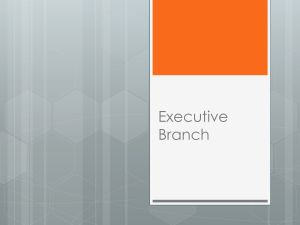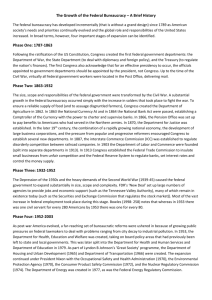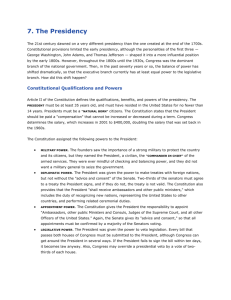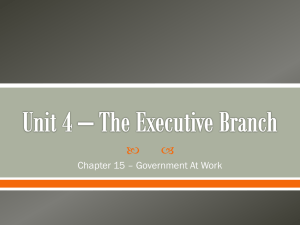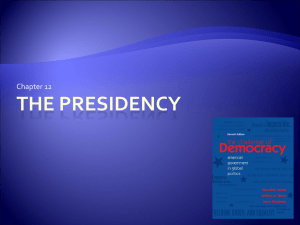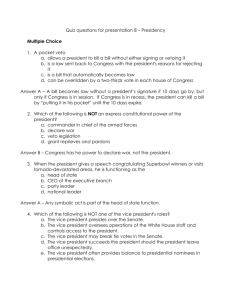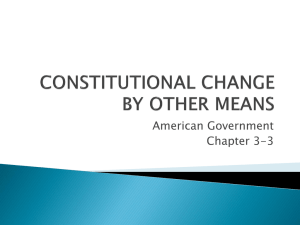7. The Presidency
advertisement
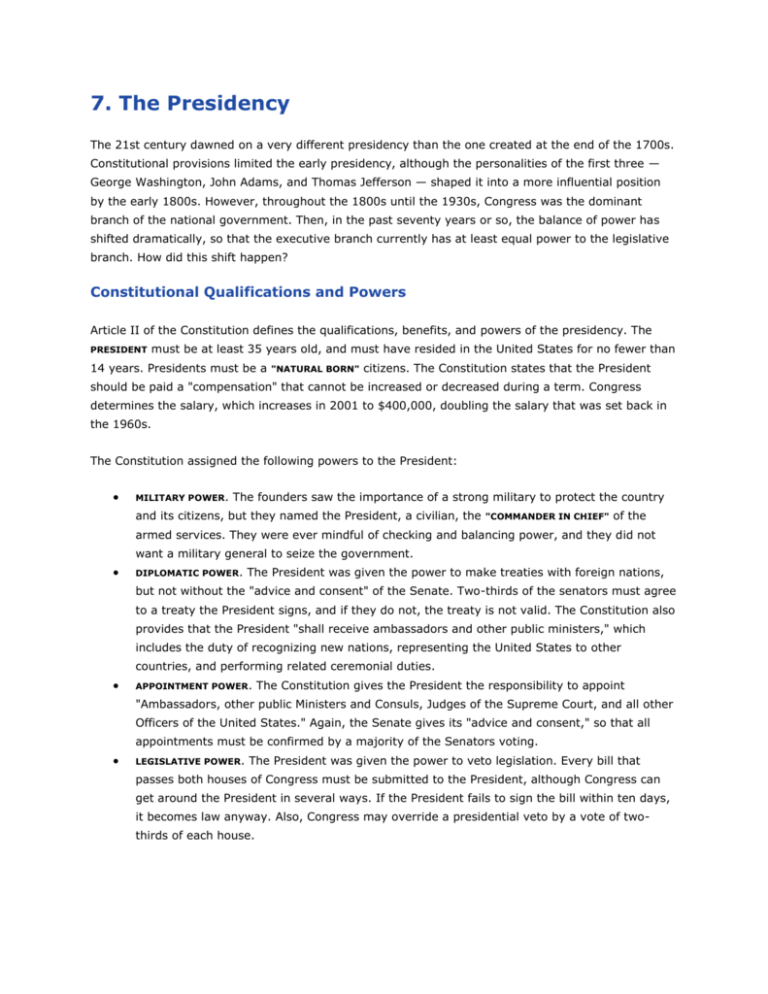
7. The Presidency The 21st century dawned on a very different presidency than the one created at the end of the 1700s. Constitutional provisions limited the early presidency, although the personalities of the first three — George Washington, John Adams, and Thomas Jefferson — shaped it into a more influential position by the early 1800s. However, throughout the 1800s until the 1930s, Congress was the dominant branch of the national government. Then, in the past seventy years or so, the balance of power has shifted dramatically, so that the executive branch currently has at least equal power to the legislative branch. How did this shift happen? Constitutional Qualifications and Powers Article II of the Constitution defines the qualifications, benefits, and powers of the presidency. The PRESIDENT must be at least 35 years old, and must have resided in the United States for no fewer than 14 years. Presidents must be a "NATURAL BORN" citizens. The Constitution states that the President should be paid a "compensation" that cannot be increased or decreased during a term. Congress determines the salary, which increases in 2001 to $400,000, doubling the salary that was set back in the 1960s. The Constitution assigned the following powers to the President: MILITARY POWER. The founders saw the importance of a strong military to protect the country and its citizens, but they named the President, a civilian, the "COMMANDER IN CHIEF" of the armed services. They were ever mindful of checking and balancing power, and they did not want a military general to seize the government. DIPLOMATIC POWER. The President was given the power to make treaties with foreign nations, but not without the "advice and consent" of the Senate. Two-thirds of the senators must agree to a treaty the President signs, and if they do not, the treaty is not valid. The Constitution also provides that the President "shall receive ambassadors and other public ministers," which includes the duty of recognizing new nations, representing the United States to other countries, and performing related ceremonial duties. APPOINTMENT POWER. The Constitution gives the President the responsibility to appoint "Ambassadors, other public Ministers and Consuls, Judges of the Supreme Court, and all other Officers of the United States." Again, the Senate gives its "advice and consent," so that all appointments must be confirmed by a majority of the Senators voting. LEGISLATIVE POWER. The President was given the power to veto legislation. Every bill that passes both houses of Congress must be submitted to the President, although Congress can get around the President in several ways. If the President fails to sign the bill within ten days, it becomes law anyway. Also, Congress may override a presidential veto by a vote of twothirds of each house. The Strengthening of the Presidency Because the Constitution gave the President such limited power, Congress dominated the executive branch until the 1930s. With only a few exceptions, Presidents played second fiddle to Congress for many years. However, those exceptions — Andrew Jackson, Abraham Lincoln, Theodore Roosevelt, and Woodrow Wilson — provided the basis for the turning point that came with the presidency of Franklin Roosevelt in the 1930s. ANDREW JACKSON, greatly loved by the masses, used his image and personal power to strengthen the developing party system by rewarding loyal followers with presidential appointments. Jackson also made extensive use of the veto and asserted national power by facing down South Carolina's nullification of a federal tariff law. Jackson vetoed more bills than the six previous Presidents combined. ABRAHAM LINCOLN assumed powers that no President before him had claimed, partly because of the emergency created by the Civil War (1861-1865). He suspended HABEAS CORPUS (the right to an appearance in court), and jailed people suspected of disloyalty. He ignored Congress by expanding the size of the army and ordering blockades of southern ports without the consent of Congress. THEODORE ROOSEVELT and WOODROW WILSON each expanded the powers of the presidency. Roosevelt worked closely with Congress, sending it messages defining his legislative powers. He also took the lead in developing the international power of the United States. Wilson helped formulate bills that Congress considered, and WORLD WAR I afforded him the opportunity to take a leading role in international affairs. Franklin Roosevelt, who was elected four times to the presidency, led the nation through the crises of the GREAT DEPRESSION and WORLD WAR II. Roosevelt gained power through his New Deal programs to regulate the economy, and the war required that he lead the country in foreign affairs as well. So, the powers of the modern presidency have been shaped by a combination of constitutional and evolutionary powers. 7b. All the President's Men and Women Just as the power of the presidency has grown tremendously in recent years, so have the numbers of people that surround the executive branch. George Washington began his first term with only one aide — his nephew — who he paid out of his own pocket. Today many advisors in the White House office, the Cabinet, and the President. EXECUTIVE OFFICE assist the The Cabinet The informal advisory body known as THE CABINET is not mentioned in the Constitution. The founders had discussed the idea of some form of national executive council, and George Washington appointed four Cabinet members (SECRETARY OF STATE, ATTORNEY GENERAL) SECRETARY OF THE TREASURY, SECRETARY OF WAR, and the shortly after his inauguration. Cabinet members must provide good advice to the President. But, they also must promote the wellbeing of their departments, sometimes at the expense of other Cabinet departments. Cabinet members are appointed by the President and confirmed by the Senate. They may be dismissed at any time. The size of the President's Cabinet has increased over the years as Presidents have recognized demands for services and governmental action. As the size of the Cabinet and their respective departments have grown, Presidents have come to rely more heavily on members of the Executive Office and the White House Staff. The Executive Office Franklin Roosevelt created the Executive Office of the President in 1939 to administer his New Deal programs. Today it consists of several advisory agencies that have worked closely with Presidents, particularly in recent years. The advisers in the Executive Office play key roles in advancing the President's agenda. Three of the most important agencies include the following: The National Security Council advises the President on American military affairs and foreign policy. The NSC consists of the President, the Vice President, and the Secretaries of State and Defense. The President's National Security Adviser runs the staff of the NSC and also advises the President. The Office of Management and Budget (OMB) is the largest office in the EOP, and it has the job of preparing the national budget that the President proposes to Congress every year. The National Economic Council helps the President with economic planning. The council consists of three leading economists and is assisted by about 60 other economists, attorneys, and political scientists. The NEC is the President's major source of advice and information about the nation's economy. The White House Office White House Office staff members are not subject to Senate confirmation, nor do they have divided loyalties. They serve the President as an "inner circle" of most trusted advisers. Many have offices in the West Wing of the White House, and they often compete for space as close as possible to the President's Oval Office. Their titles include Special Assistant, Counsel, Aide, and Press Secretary. Staff members gather information, write reports, give advice, lobby lawmakers, and present the President's views to the media. The Chief of Staff is usually particularly influential as the director of all the operations of the White House Office. The job of presiding over the nation's government requires many assistants and administrators. Some people have criticized recent Presidents for having such a large staff in the executive offices. Recent Presidents have tried to cut back, but they generally have found that this large, complex country would be difficult to run without them. The President’s Job Just what exactly does the President do all day? The evolving power and enlarging scope of responsibilities have made the modern presidency a very big job. Some even say that it is impossible for one person to handle it all. Presidents as Crisis Managers The Constitutional power as "Commander in Chief" has evolved into the very important modern role of "crisis manager." In the 20th century, as the United States gained world leadership powers, the President has become a key player in international crises. In the case of war — such as the Korean War, the Vietnam War, and the Persian Gulf War — or less famous regional conflicts — such as those in Kosovo, Somalia, or Haiti — the President must go into "emergency mode" and concentrate on the immediate problem. Domestically, crises may occur — such as urban riots, hurricanes, or forest fires — that require the President to schedule time to coordinate government responses to the situation. Presidents as Symbols and Administrators More than anyone else, the President symbolizes the country — its people and its beliefs. In this role, a President performs many ceremonial duties, such as receiving foreign dignitaries, throwing the first baseball of the season, and walking on red carpets while waving to crowds. These actions are not trivial. Strong Presidents must exude confidence, not just in themselves, but in the American people as well. The best ones have had an intangible charisma that engendered public confidence. As leader of the executive branch, the President is primarily responsible for seeing that the work of government is done. A famous sign sat on President Harry Truman's desk, "The buck stops here." The responsibility to administer and execute the laws of the land squarely rests on the President's shoulders. The president must therefore recruit and appoint many people to top government jobs. Cabinet members, many sub-Cabinet positions, federal judges including Supreme Court Justices, ambassadors, top military leaders, and heads of independent government agencies are all appointments filled by the President. Even though nominees are subject to consent by the Senate, the fact that Presidents control more than 4,000 appointments to government service makes this responsibility an important one. Presidents as Agenda Setters Setting a political agenda has been a role that has grown in recent years. The founders clearly intended that Congress take the lead in setting priorities and determining policies. Today, Presidents have plans for Social Security, welfare programs, taxes, inflation, and public education. In foreign policy, they often act first, and then consult Congress. Virtually all recent Presidents regularly recommend legislation to Congress. Strong Presidents have used the State of the Union address, given yearly at the start of each congressional session, to set an agenda. Modern Presidents now use the media to bring attention to their proposals and to place pressure on legislators. A President may threaten a veto before the bill gets to the Oval Office. This action lets legislators know the President's agenda and pressures them to rethink bills that they know will be vetoed. Can any one person hope to be able to successfully hold the President's job? The great author John Steinbeck commented, " We give the President more work than a man can do, more responsibility than a man should take, more pressure than a man can bear." Yet, recent Presidents somehow have managed to endure — although the job has exacted a tremendous toll on each of them. What are you responsible for knowing? 1. How has the relationship of Congress and the President changed since the 1930s? 2. What presidents were instrumental in expanding the power of the presidency? 3. What are the cabinet, the Executive Office of the President, and the White House Office? 4. What methods do Presidents use to try to set the legislative agenda for Congress? 8. The Bureaucracy: The Real Government A bureaucrat is someone who works in administrative capacity for the government. How important are bureaucrats and their government agencies in actually running the United States government? According to some, they are the real government — the ones behind the scenes who go to work when the politicians are enjoying the spotlight. Most estimates suggest there are probably more than 2,000 federal government agencies, commissions, and departments. They each have an area of specialization — some much broader than others — but their duties often overlap, making administration more difficult. To complicate things even more, many agencies have counterparts at the state and local level. Its size, complexity, and overlapping responsibilities leave the federal bureaucracy open to constant attempts to reorganize and streamline. Congress has the power to create, organize, and disband all federal agencies. Most of them are under the control of the President, although few of them actually have direct contact with the White House. So, the bureaucracy has two masters — Congress and the President. The bureaucracy generally falls into four broad types: Cabinet departments, government corporations, independent agencies, and regulatory commissions The Cabinet Departments The 15 Cabinet departments are each headed by a Secretary who sits on the President's Cabinet. The exception is the Justice Department, which is headed by the Attorney General, who is also a member of the President's Cabinet. The Secretaries are responsible for directing the department's policy and for overseeing its operation. Each has a special area of policy, although their responsibilities are still very broad. The organization of each is quite complex, but they have some things in common. All Secretaries have a Deputy or Undersecretary, as well as a host of Assistant Secretaries, who all direct major programs within the department. Most departments are divided into bureaus, divisions, and sections. For example, the FBI lies within the domain of the Justice Department, and the Secret Service is within the Department of Homeland Security . Government Corporations Government corporations do not belong to any department — they stand on their own. Probably the best-known government corporations are the United States Postal Service and Amtrak. They are different from other agencies in that they are businesses created by Congress, and they charge fees for their services. Like any other business, government corporations have private competition — such as Federal Express and United Parcel Service — and sometimes state competition — such as the New Jersey Transit Authority. Independent Agencies Independent agencies closely resemble Cabinet departments, but they are smaller and less complex. Generally, they have narrower areas of responsibility than do Cabinet departments. Most of these agencies are not free from presidential control and are independent only in the sense that they are not part of a department. Congress creates them as separate agencies for many reasons, practical as well as symbolic. For example, when the National Aeronautics and Space Administration (NASA) was established, many members of Congress assumed that it would be a part of the Department of Defense. However, it is an independent agency because the space program has many other purposes than the defense of the nation. Regulatory Agencies These agencies regulate important parts of the economy, making rules for large industries and businesses that affect the interests of the public. Because regulatory commissions are "watchdogs" that by their very nature need to operate independently, they are not part of a department, and the President does not directly control most of them. Each commission has from 5 to 11 members appointed by the President, but the President cannot remove them for the length of their terms in office. Examples of these commissions are the Securities and Exchange Commission, which regulates the stock market, brokers, and investment practices. Another well-known commission is the Federal Reserve Board that governs the nation's monetary policy. The Environmental Protection Agency serves as a guardian over the nation's environment, making and enforcing standards for the industrial and commercial sectors. With over 2,000 different agencies, the federal bureaucracy is almost certain to run into problems with organization, overlapping responsibilities, and efficiency. Almost every recent President has come into office determined to refashion and trim the bureaucracy. However, none has been able to make more than minor adjustments. Well-established agencies have lives of their own, and are difficult to change. Besides, the country has large, complex, needs requiring special attention. A large bureaucracy is a part of the government's attempt to meet those needs. 8b. Who Are the Bureaucrats? The 4 million Americans who work for the federal government have many faces and do many jobs. For starters, over 1.4 million are in military service. Overall, they represent much more of a cross section of the American population than do members of Congress or federal judges. About 43% are women, and 28% represent minority groups. What Do Bureaucrats Do? Congress passes laws, but it cannot follow through on all the little decisions that have to be made as the law is translated into action. Bureaucrats, then, may make policies and choose actions that are not spelled out in advance by laws. Congress delegates substantial authority to administrative agencies in several areas: 1. Paying subsidies — government support money — to farmers, veterans, scientists, schools, universities, and hospitals 2. Transferring money to state and local governments for grants-in-aid, such as highway building, city improvements, or educational programs. 3. Devising and enforcing regulations, such as who owns television stations, what safety features automobiles have, and what kinds of scientific research will be specially encouraged. About 90% of all federal bureaucrats are hired under regulations of the civil service system. Most of them take a written examination administered by the Office of Personnel Management (OPM) and they meet selection criteria, such as training, education levels, or prior experience. Some of them take special tests and meet special criteria, such as postal employees, FBI agents, CIA intelligence officers, foreign-service officers, and doctors in the Public Health Service. The variety of people who work for the federal bureaucracy is greater than most people realize. They may do scientific research, clerk in welfare offices, decide burn policies for national forests, or do undercover intelligence work. They are all a part of the process whereby the government fulfills the many expectations that Americans have for it today. What are you responsible for knowing? 1. What are bureaucrats and the bureaucracy? 2. Identify four different types of organizations in the bureaucracy and give an example of each? 3. Why are bureaucrats necessary?


